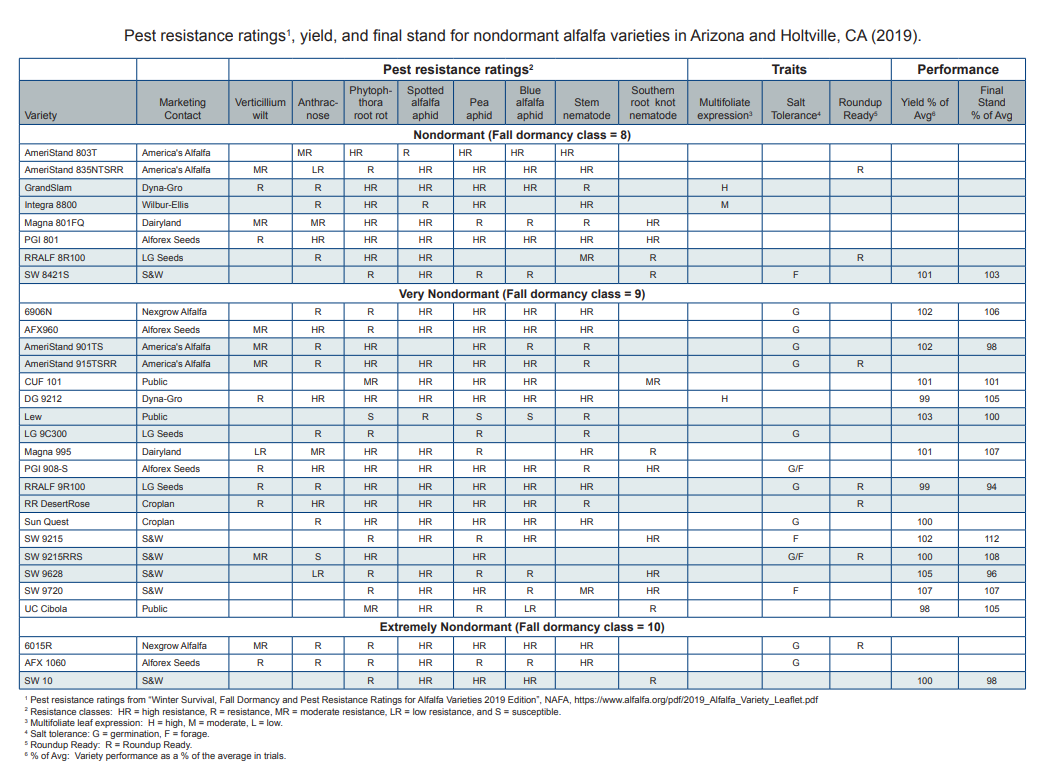How to select an alfalfa variety:
Determine an appropriate fall dormancy class Alfalfa varieties differ in fall dormancy, defined as growth during the fall. Nondormant alfalfa varieties are usually planted in mild winter areas for their ability to grow in the fall. However, fall growth of nondormant alfalfa may be undesirable in areas subject to repeated frosts or freezes. Nondormant, very nondormant, and extremely nondormant alfalfa varieties (fall dormancy class 8, 9, and 10) are adapted to elevations below 4000 feet in Arizona. Other dormancy classes not included in this publication are moderately nondormant varieties (fall dormancy class 7) which may be grown from 3000 to 5000 feet, and semi-dormant and dormant varieties (fall dormancy 6 and below) which are adapted to colder winter areas above 4000 feet.
Identify potential pest problems
Select alfalfa varieties that have resistance to potential pest problems. Variety resistance is not available or not characterized for many important pests. However, pest resistance ratings are provided in this publication for verticillium wilt, anthracnose, phytophthora root rot, various aphids, and stem and root knot nematode. Verticillium wilt has been detected in Arizona hay shipments to China, but has not been positively identified in the field. Anthracnose occurs in the lower Colorado River area during hot, humid weather. Phytophthora root rot can be a problem on poorly drained soils during cool weather. Aphids occur in most production areas. Stem nematode has been reported in Maricopa, Pinal, Graham, and Yuma Counties. Root knot nematode has been identified in the lower Colorado River area, but usually is not important. Some diseases common to other alfalfa production areas such as bacterial and fusarium wilt are not known to occur in Arizona.
Decide on importance of salt tolerance and Roundup Ready
Alfalfa varieties are available that have salt tolerance or are Roundup Ready. Ratings are provided in this publication.
Determine the importance of yield and stand
Many of the varieties listed in this publication have been tested for yield and final stand by the University of Arizona in small plot trials. A summary of these trials is provided on the facing page. Most of these trials were conducted at Maricopa or Tucson. Field-test several promising varieties Plant several promising varieties in narrow strips or small areas of a few acres and evaluate performance under your own conditions.
Choose a variety (or two) for large-scale planting
Plant new varieties on no more than 25% of the newly seeded acreage. Planting inexpensive seed of a poorly-adapted variety costs in the long-run. A difference in seed cost of $1.00 per pound is easily recovered by a more productive variety in the first year. Non-certified seed is also undesirable due to poor seed quality, introduction of weeds, and the possibility of planting an incorrectly identified variety with undesirable characteristics.
